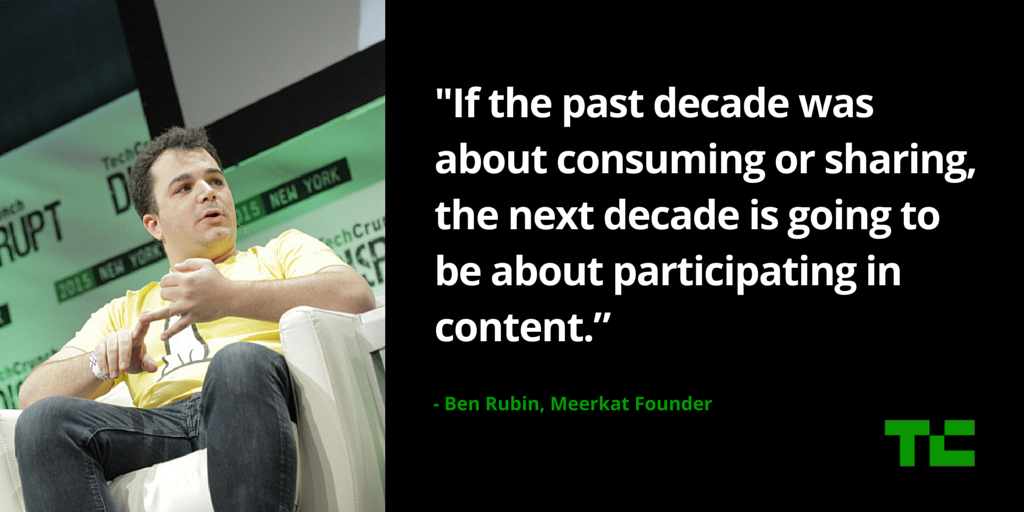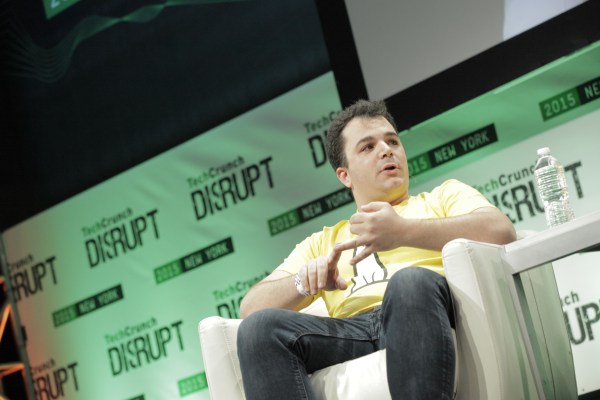Meerkat founder Ben Rubin has criticized Twitter for only giving the live streaming startup two hours’ notice before pulling the plug on access to its social graph. Speaking onstage with TechCrunch’s Josh Constine here at Disrupt NY, Rubin said: “Big platforms should take leadership coming from courage and not fear.”
He added that getting a call from Twitter with just two hours’ notice to change the product “sucked.”
“You get this call and they say ‘hey, we really like the product but… by the rules you cannot use the graph in a competitive way and we just launched Periscope in a beta and we’re going to close it’.”
“It was Saturday – all the team went back to the office to get ready to dive in,” he added.
Rubin was not critical of the actual decision Twitter made, noting it is just following its own rules about shutting off access to rival products. For context, Twitter bought live-streaming startup Periscope, and launched a beta service shortly after Meerkat had launched its own app.
Prior to Periscope’s arrival, Meerkat had gained attention and traction after Apple featured it in the Best New App category. But even that favor proved fickle — with Apple subsequently using the category to promote the shiny new live-streaming app Periscope. Such is the blistering pace of tech.
While Meerkat has undoubtedly dropped down the app download rankings after its early fortune – Rubin confirmed onstage download rates have indeed dropped – he revealed it now has around 2 million users. And he rejected the idea that the market for live-streaming will not be able to accommodate more than one big player.
“The way our team looks at it is there is a new medium called one-to-many-synchronous. And the old medium or what we know until now is one-to-many-asynchronous. And in [that] there is Facebook, Twitter, Instagram, YouTube, Yik Yak, Snapchat Stories… So with many different products of communication on one-to-many-asynchronous, it would be hilarious to say Twitter cannot exist because you post statuses on your Facebook. Or Instagram cannot exist because you post photos on your Facebook.
“It would be ridiculous to say in one-to-many-synchronous there’s going to be only one winner. Because there’s going to be multiple products there, the same that we see in one-to-many-asynchronous.”
“Mediums – their job is to support self-expression,” he added. “If you look at one-to-many-synchronous there is Twitch, that’s all. There’s a $1 billion company on a gaming vertical, that’s all. The rest is radio and live TV.”
Rubin said Meerkat intends to differentiate in the live-streaming space by what he described as “pulling many to one,” as opposed to “pushing one to many” – à la rival products like Periscope and Twitter. His watch words for Meerkat are participation and collaboration.
“The way we see our product is a product that is pull-many-to-one to participate. Even if you open it up now you see the audience is in front of the content, and not behind the content. The way we see it is the medium will be successful when we change the type of content – and the type of content should change because this is live streams,” he said.
“You can change the content when you empower the audience to take part in the content, not consume. If the past decade was about consuming or sharing, the next decade is going to be about participating in content.”

“We just introduced an emoji feature and comments are there so you can have conversations, and there’s more stuff in collaborative streaming that we’re going to introduce,” he added.
Rubin also hinted at his long-term vision – looking beyond three to five years — for a live-streaming business model: namely by creating a medium that people are willing to pay for because it feels so immersive and offers them interaction options they can’t get elsewhere.
For now, though, Meerkat is launching a developer platform and APIs so outsiders can build companion tools for Meerkat.
“When we as an audience start taking part in content we have a much more emotional commitment, an emotional connection to content… and that will eventually in the long run when the format evolves to other stuff [mean people are willing to pay],” he said.
“This format will be very exciting when you take part in it and it’s produced in a high quality of production that you will actually pay for it… When it is a high quality of production and I can feel that I’m actually there, there’s a whole vertical of virtual reality we haven’t talked about. That I can feel I’m actually there and I can change their content I think you would pay much more than you pay per view for that. But I’m talking not anywhere near term.”
For more on Meerkat, check out our follow up:
“Meerkat Launches Developer Platform To Differentiate From Periscope“
